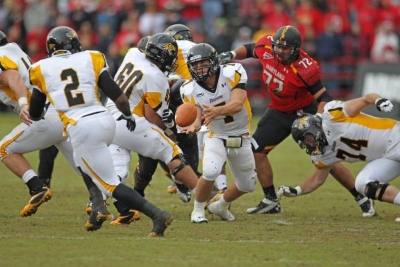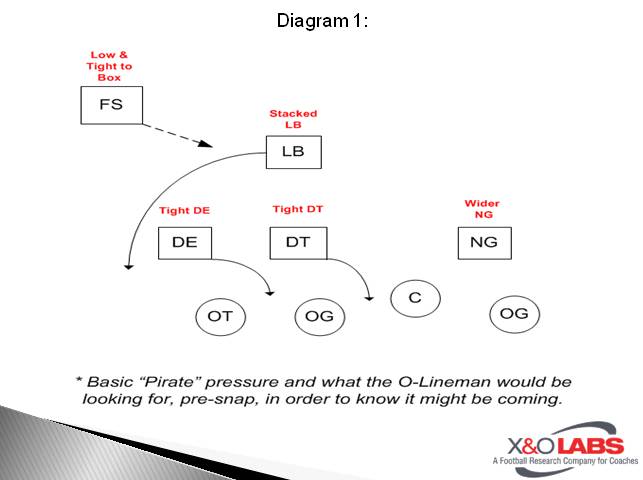John Donatelli - @jdonatelli53
Offensive Line Coach
Towson University
 Introduction:
Introduction:In teaching linemen to asses the defense pre-snap you will be teaching them to not necessarily identify the overall front structure, but training them to asses the alignment of the defenders and then process what attack angles or movement can be produced from the defender’s individual alignments.
In order to execute what I call a proper “Pre-Snap Cerebral Process,” linemen must walk themselves through a few simple questions before the snap of the ball. We have found that this approach has a variety of benefits. Understanding the play concept completely allows linemen to truly get an understanding before the snap of the ball as to how the defense will react to and fit the play. We are able to push our players far past their particular assignment and deepen their knowledge. We have found that this approach speaks to the individual player’s knowledge of the play and gives them a process to understand how their role in the scheme is impacted by those around them.
Here is the progression that our players here at Towson work through each play and the benefit of each individual question:
What is the play’s point of attack?
We teach our players that this process starts with understanding “attack point” of the play. This forces the player to take his assignment to be more than just a line on a page. Instead, he is forced to determine how he can execute his assignment to enhance our team’s ability at the point of attack.
What is the alignment of the defenders?
Analyzing the alignment of the defenders pre-snap is crucial to success. For us, that means taking account for more than just the defender lined up over him. We teach our players that they also must process how the two hard defenders to his right and left are aligned. Examples below:
- OT Alignment Keys: Includes the DE and DT or NT
- OG Alignment Keys: Includes the NT and DT or DE
- C Alignment Keys: Include the DT and NG
In each case, the lineman will assess the width of each defender in regards to how tight or lose in alignment they are. The linemen must be trained to then turn their attention to the alignment of the LB over him. When assessing the linebacker, the lineman must be sure to account for both the width and depth of LB’s position.
Assessing these three points will provide the lineman with a base understanding of what could possibly be occurring on the other side of the ball. In order to further his knowledge of the defense, the player must take his assessment to the next level and process more than just those three points, two hard defenders and one linebacker.
Once they get a handle on understanding those three points, we teach our players to assess their entire half of the defense. This would mean reading the pre-snap alignment of all the hard defenders (including opposite NG for the guards), linebackers and safeties on their side of the ball. Each individual lineman’s ability to process the alignment of these defenders will unlock the defense’s intentions (most of the time), giving your linemen the advantage.
What can the defenders do from that alignment?
After processing the alignment of the defenders, linemen will have a very good understanding of what the movement or pressure the defense is about to employ on any given play. At this point, the alignment information will converge with what each lineman has learned through the week of preparation and film study. In most cases, our players will have a very good idea what tactic the defense is about to employ based on the details of the alignments against our particular formation. This information helps the player make decisions about what tools to use (next step). The best part of this process is that over time we see our lineman being able to apply this knowledge of defensive structures on the fly. In some cases, they not need much specific film study to understand by pre-snap alignment what the defense is about to do. When your lineman get to that point, your offense is going to be able to able to adjust to almost anything in game situations.

What tools are needed to solve the problem presented by the defense?
The last step in training the eyes to unlock the defense is what “tools” are needed to solve the problem that is being presented. This speaks specifically to the individual lineman’s choice of footwork and what steps he will use on his angle of departures to allow him to be the most efficient. Of course, every blocking scheme or concept we teach has a certain base set of footwork principles to go along with it. However, it is critical for us to teach the player that the footwork often is and should be based off of the defender’s alignment. That is where the technique meets the situation and the player must learn to make the small changes needed to address the scheme.
How this relates to our most proficient run scheme: Middle Zone Scheme
We use all of these processes to design our Middle Zone concept, which has averaged over five yards per play the last two seasons. Once my linemen are able to understand the relevance of these questions, they are able to transfer that knowledge into successfully blocking our Middle Zone concept, which is detailed in its entirety below.
The Mid Zone is an underutilized concept in college football today. Most Zone attacks focus on and are structured to attack the Inside Zone , between the tackles or Stretch concept attacking a landmark outside the tight e








